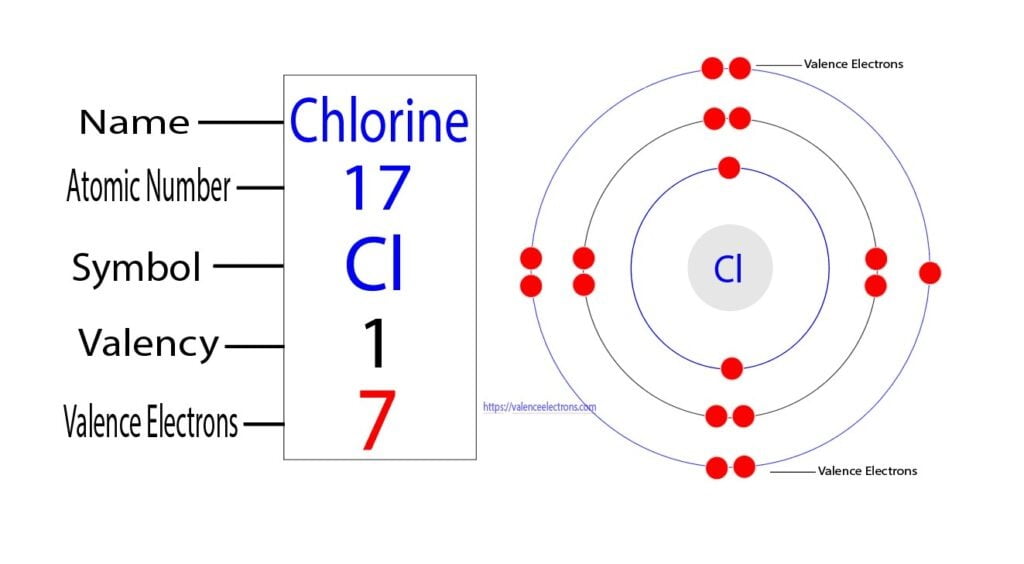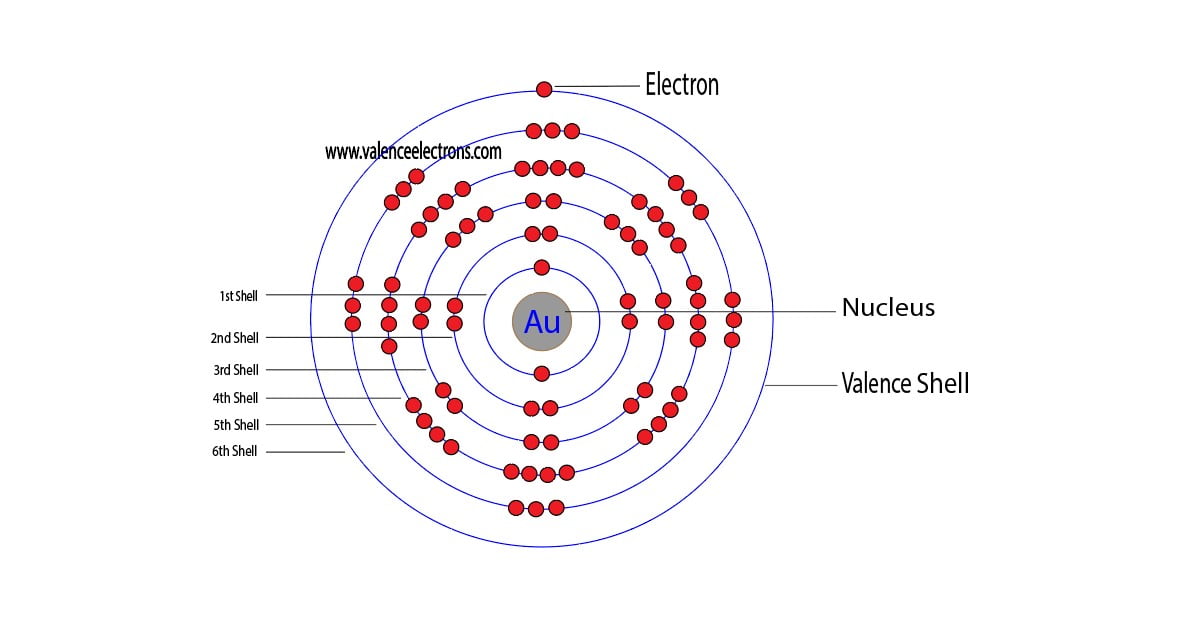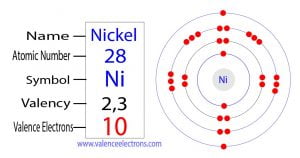How to Find the Valence Electrons for Chlorine (Cl)?
The 17th element of the periodic table is chlorine and it is also an element of group-17. Its symbol is ‘Cl’. Chlorine forms bonds through its valence electrons.
What are the valence electrons of chlorine?
Chlorine is a non-metallic element and also a halogen element. The valence electrons are the total number of electrons in the last orbit(shell).
The total number of electrons in the last shell after the electron configuration of chlorine is called the valence electrons of chlorine.
The valence electrons determine the properties of the element and participate in the formation of bonds.

How do you calculate the number of valence electrons in a chlorine atom?
The valence electrons have to be determined by following a few steps. The electron configuration is one of them. It is not possible to determine the valence electron without electron configuration.
Knowing the electron configuration in the right way, it is very easy to determine the valence electrons of all the elements.
However, valence electrons can be easily identified by arranging electrons according to the Bohr principle. Now we will learn how to determine the valence electron of chlorine.
Step-1: Determining the total number of electrons in chlorine
1st we need to know the total number of electrons in the chlorine atom. To know the number of electrons, you need to know the number of protons in chlorine.
And to know the number of protons, you need to know the atomic number of the chlorine element. To know the atomic number we need to take the help of a periodic table.
It is necessary to know the atomic number of chlorine elements from the periodic table. The atomic number is the number of protons. And electrons equal to protons are located outside the nucleus.

That is, we can finally say that there are electrons equal to the atomic number in the chlorine atom. From the periodic table, we see that the atomic number of chlorine is 17. That is, the chlorine atom has a total of seventeen electrons.
Step-2: Need to do electron configuration of chlorine
Step 2 is very important. In this step, the electrons of chlorine have to be arranged. The electron configuration of chlorine shows that there are two electrons in the K shell, eight in the L shell, and seven in the M shell.

That is, the first shell of chlorine has two electrons, the second shell has eight electrons and the 3rd shell has seven electrons.
Step-3: Determine the valence shell and calculate the total electrons
The third step is to diagnose the valence shell. The last shell after the electron configuration is called the valence shell. The total number of electrons in a valence shell is called valence electrons.
The electron configuration shows that the last shell of chlorine has seven electrons. Therefore, the valence electrons of chlorine are seven.
Video for How to Find the Valence Electrons for Chlorine (Cl)
What is the valency of chlorine?
The ability of one atom of an element to join another atom during the formation of a molecule is called valency(valence). The number of unpaired electrons in the last orbit of an element is the valency of that element.
The correct electron configuration of chlorine(Cl) in ground state will be 1s2 2s2 2p6 3s2 3px2 3py2 3pz1.
This electron configuration shows that the last shell of the chlorine atom has an unpaired electron(3pz1). So the valency of chlorine is 1.
The oxidation states of chlorine change depending on the excitation. Oxidation states of chlorine are −1, +1, +2, +3, +4, +5, +6, +7.

How many valence electrons does chloride ion(Cl–) have?
The elements that have 5, 6, or 7 electrons in the last shell receive the electrons in the last shell during bond formation. The elements that receive electrons and form bonds are called anions.
During the formation of a bond, the last shell of chlorine receives an electron and turns into a chloride ion(Cl–). That is, chlorine is an anion element.
Cl + e– → Cl–
The electron configuration of chloride ion(Cl–) is 1s2 2s2 2p6 3s2 3p6.
The electron configuration of chlorine ions shows that chloride ion have three shells and the 3rd shell has eight electrons.
This electron configuration shows that the chloride ion has acquired the electron configuration of argon.
That is, in this case, the valency of chlorine ions is -1. Since the last shell of chloride ion has eight electrons, the valence electrons of chloride ion(Cl–) are eight.
Compound formation of chlorine
Chlorine participates in the formation of bonds through its valence electron. These valence electrons participate in the formation of bonds with atoms of other elements.
The electron configuration of sodium shows that the valence electrons of sodium are one. The sodium atom donates its valence electrons to the chlorine atom and the chlorine atom receives that electron.

As a result, chlorine acquires the electron configuration of argon and the sodium atom acquires the electron configuration of neon.
Chlorine and sodium atoms form sodium chloride(NaCl) bonds through electron exchange. Sodium chloride(NaCl) is ionic bonding.
FAQs
How many valence electrons does chlorine have?
Ans: 7 valence electrons. The last shell of chlorine has seven electrons. Therefore, the valence electrons of chlorine are seven.
How many valence electrons does chloride (cl-) have?
Ans: 8 valence electrons. The electron configuration of chloride ion(Cl–) is 1s2 2s2 2p6 3s2 3p6. The electron configuration of chlorine ions shows that chloride ion have three shells and the 3rd shell has eight electrons. Since the last shell of chloride ion has eight electrons, the valence electrons of chloride ion(Cl–) are eight.
How many shells does chlorine have?
Ans: Three shells.
What is the valency of chlorine?
Ans: The valency of chlorine is 1. The correct electron configuration of chlorine in ground state will be 1s2 2s2 2p6 3s2 3px2 3py2 3pz1.
This electron configuration shows that the last shell of the chlorine atom has an unpaired electron(3pz1). So the valency of chlorine is 1.How many electron shells does chlorine have?
Ans: Chlorine has a total of three electron shells.
What is the valency of chloride?
Ans: The electron configuration of chloride ion(Cl–) is 1s2 2s2 2p6 3s2 3p6. The electron configuration of chlorine ions shows that chloride ion have three shells and the 3rd shell has eight electrons. This electron configuration shows that the chloride ion has acquired the electron configuration of argon.
That is, in this case, the valency of chloride ion is -1.How many electrons does chlorine have in its outer shell?
Ans: Chlorine has a total of seven electrons in its outer shell. The order of the number of electrons in each shell of chlorine(Cl) atom is 2, 8, 7.
How many valence electrons does the lewis structure for a chlorine atom show?
Ans: The Lewis structure for a chlorine atom shows seven valence electrons.
How many electrons does chlorine have in its valence shell?
Ans: The total number of electrons in a valence shell is called valence electrons. The valence shell of chlorine has seven electrons.
How many valence electrons does a neutral atom of chlorine have?
Ans: The ground state electron configuration of chlorine is 1s2 2s2 2p6 3s2 3p5. A neutral atom of chlorine has seven valence electrons.
How many valence electrons are in a chlorine atom and a chloride ion?
Ans: A chlorine atom has seven valence electrons and a chloride ion has eight valence electrons.






